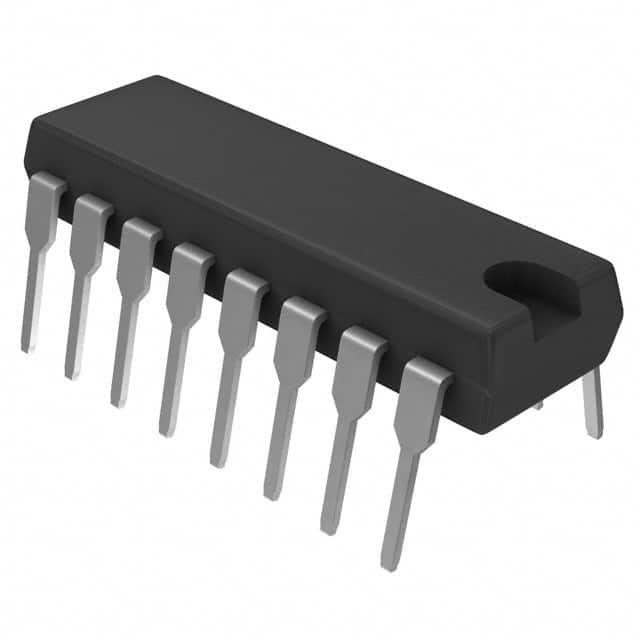74HC123N,652
Basic Information Overview
- Category: Integrated Circuit (IC)
- Use: Multivibrator and Timer
- Characteristics: High-speed operation, low power consumption
- Package: DIP-16 (Dual In-line Package with 16 pins)
- Essence: Monostable Multivibrator
- Packaging/Quantity: Tape and Reel, 2500 units per reel
Specifications
- Supply Voltage Range: 2V to 6V
- High-Level Input Voltage: 2V to VCC
- Low-Level Input Voltage: GND to 0.8V
- High-Level Output Voltage: VCC - 0.5V
- Low-Level Output Voltage: 0.5V
- Maximum Operating Frequency: 33 MHz
- Propagation Delay Time: 20 ns
- Trigger Pulse Width: 30 ns
Detailed Pin Configuration
- CLR (Clear) - Active LOW input for resetting the timer
- E (Enable) - Active HIGH input for enabling or disabling the timer
- A (Trigger) - Active LOW input for triggering the timer
- B (Threshold) - Active LOW input for setting the time duration
- RC (Resistor-Capacitor) - External resistor-capacitor timing components
- Q (Output) - Output of the monostable multivibrator
- GND (Ground) - Ground reference
- Qn (Complementary Output) - Complementary output of the monostable multivibrator
- NC (No Connection) - No electrical connection
- NC (No Connection) - No electrical connection
- NC (No Connection) - No electrical connection
- NC (No Connection) - No electrical connection
- NC (No Connection) - No electrical connection
- VCC (Positive Power Supply) - Positive power supply voltage
- NC (No Connection) - No electrical connection
- NC (No Connection) - No electrical connection
Functional Features
- Monostable Multivibrator: Generates a single output pulse of a fixed duration when triggered
- High-Speed Operation: Allows for quick response times in timing applications
- Low Power Consumption: Ideal for battery-powered devices and energy-efficient designs
- Wide Supply Voltage Range: Can operate with a wide range of power supply voltages
- Schmitt Trigger Inputs: Provides hysteresis to improve noise immunity and signal integrity
Advantages and Disadvantages
Advantages
- Precise Timing Control: The 74HC123N,652 allows for accurate timing control in various applications.
- Versatile Use: It can be used in a wide range of electronic circuits requiring monostable multivibrator functionality.
- Easy Integration: The IC is available in a standard DIP-16 package, making it easy to integrate into existing designs.
- Cost-Effective: The 74HC123N,652 offers a cost-effective solution for timing applications.
Disadvantages
- Limited Time Duration: The maximum time duration of the output pulse is determined by external resistor-capacitor components.
- Single Output Pulse: The IC generates only a single output pulse upon triggering and requires retriggering for subsequent pulses.
Working Principles
The 74HC123N,652 is a monostable multivibrator that generates a single output pulse of a fixed duration when triggered. The duration of the output pulse is determined by external resistor-capacitor timing components connected to the RC pin. The timer can be enabled or disabled using the E pin, and the output pulse can be reset using the CLR pin. The A and B pins are used for triggering and setting the time duration, respectively. The IC operates at high speed and consumes low power, making it suitable for various timing applications.
Detailed Application Field Plans
The 74HC123N,652 can be used in a wide range of electronic circuits that require precise timing control. Some common application fields include:
- Pulse Width Modulation (PWM) Generation: The IC can be used to generate variable-width pulses for controlling motor speed, LED brightness, or audio volume.
- Timing Delays: It can be utilized to introduce specific time delays in circuits, such as in debouncing switches or triggering sequential events.
- Frequency Division: The IC can divide an input frequency by a fixed factor, enabling frequency division in digital systems.
- Oscillator Circuits: It can be employed to generate clock signals or square wave oscillations in microcontroller-based systems.
- Sequential Logic Circuits: The monostable multivibrator functionality of the IC can be utilized in sequential logic circuits for generating precise timing sequences.
Detailed and Complete Alternative Models
- CD74HC123E: Similar monostable multivibrator IC with the same pin configuration but available in a different package (
10个与74HC123N,652在技术解决方案中的应用相关的常见问题及解答
Sure! Here are 10 common questions and answers related to the application of 74HC123N,652 in technical solutions:
Q: What is the 74HC123N,652? A: The 74HC123N,652 is a dual retriggerable monostable multivibrator IC, commonly used in timing and control applications.
Q: What is the operating voltage range for the 74HC123N,652? A: The operating voltage range for this IC is typically between 2V and 6V.
Q: How many inputs does the 74HC123N,652 have? A: This IC has two inputs, labeled as A and B.
Q: What is the purpose of the retriggerable feature in this IC? A: The retriggerable feature allows the output pulse width to be extended if additional trigger pulses are received during the monostable period.
Q: Can the 74HC123N,652 be used as a frequency divider? A: No, this IC is not designed for frequency division. It is primarily used for generating precise time delays.
Q: What is the maximum output current that can be sourced or sunk by the 74HC123N,652? A: The maximum output current is typically around 4mA.
Q: How do I calculate the output pulse width for a given RC network connected to the 74HC123N,652? A: The output pulse width can be calculated using the formula: t = 0.693 * (R * C), where R is the resistance and C is the capacitance in the RC network.
Q: Can I use the 74HC123N,652 in high-speed applications? A: Yes, this IC is designed for high-speed operation and can be used in applications where precise timing is required.
Q: What is the typical propagation delay of the 74HC123N,652? A: The typical propagation delay is around 15 ns.
Q: Can I cascade multiple 74HC123N,652 ICs to achieve longer time delays? A: Yes, you can cascade multiple ICs by connecting the output of one IC to the input of another to achieve longer time delays.
Please note that these answers are general and may vary depending on specific datasheet specifications and application requirements.


